Are you ready for a delicious and exciting culinary experience? Look no further than the versatile and delightful raspberry! This vibrant fruit is not only a treat for the taste buds but also a versatile ingredient that can add a burst of flavor to both sweet and savory dishes. With its range of varieties and numerous health benefits, raspberries are a must-have in your kitchen.
From red, golden, black, purple, to heritage raspberries, the options are endless when it comes to incorporating these berries into your cooking. Whether you’re indulging in a mouth-watering Raspberry Tart or adding a tangy Raspberry Glaze to your grilled meats, the possibilities with raspberries are truly endless.
Join me in this tantalizing journey as we dive into the fascinating history of raspberries in cooking, explore the different types available, and discover tips on selecting and storing these luscious fruits for maximum flavor.
Key Takeaways:
- Raspberries are a versatile fruit that can be used in both sweet and savory dishes.
- There are various types of raspberries, each with its own unique flavor profile.
- Choosing ripe and flavorful raspberries is essential for the best culinary results.
- Proper storage techniques can help prolong the freshness of raspberries.
- Raspberries offer numerous health benefits, including antioxidants and vitamins.
The History of Raspberries in Cooking
Raspberries have a rich history in the culinary world, dating back centuries. These vibrant berries were not only cherished for their delectable taste but were also revered for their medicinal properties. Ancient Greek and Roman writings mention the cultivation and consumption of raspberries, highlighting their significance in historical cooking.
“Raspberries are one of the most beloved fruits in cooking,” says renowned chef Julia Smith. “Their unique flavor and versatility make them a valuable ingredient in both sweet and savory dishes.”
“The tartness of raspberries adds complexity and depth to desserts like pies, cakes, and tarts,” explains Chef Smith. “They can also be used to create delightful sauces, jams, and syrups.”
In addition to their culinary appeal, raspberries offer numerous health benefits. These vibrant berries are packed with antioxidants, vitamins, and dietary fiber, making them a nutritious choice for any meal. Incorporating raspberries into your recipes not only enhances their taste but also adds a boost of beneficial nutrients.
The Versatility of Raspberries in Cooking
Raspberries are incredibly versatile in the kitchen, allowing for creative exploration in various dishes. Their vibrant color and tart-sweet flavor make them a standout ingredient, whether used in sweet or savory preparations.
“The versatility of raspberries is truly remarkable,” says Chef Smith. “You can incorporate them into anything from refreshing salads and savory glazes for meats to decadent desserts like pies and cakes.”
Raspberries can also be used as a topping for yogurt, blended into smoothies, or even enjoyed on their own as a refreshing snack. With their endless possibilities, raspberries can elevate any dish, adding a burst of flavor and visual appeal.
| Raspberry Benefits | Raspberry Recipes |
|---|---|
| Rich in antioxidants | Raspberry Cheesecake |
| High in vitamin C | Raspberry Lemon Bars |
| Good source of dietary fiber | Raspberry Spinach Salad |
| May help reduce inflammation | Raspberry Balsamic Glazed Salmon |
Whether you’re a seasoned chef or a cooking enthusiast, experimenting with raspberry recipes can open up a world of exciting flavors and culinary possibilities. So, let your creativity flow and enjoy the deliciousness that raspberries bring to your kitchen.
Types of Raspberries for Cooking
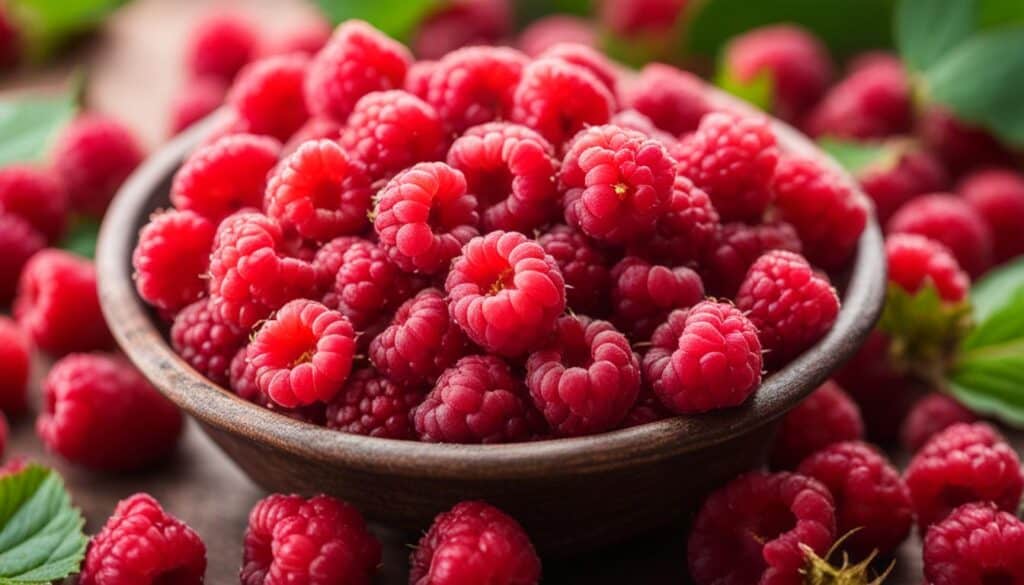
When it comes to cooking with raspberries, there are several types to choose from, each offering its own unique characteristics and flavors. Here are the different types of raspberries that are commonly used in culinary endeavors:
Red Raspberries
Red raspberries are the most common variety and are perfect for both eating fresh and incorporating into recipes. They have a sweet and slightly tangy flavor that pairs well with a variety of ingredients. Red raspberries are also known for their vibrant red color, making them a visually appealing addition to any dish.
Golden Raspberries
Golden raspberries have a milder flavor compared to red raspberries, with a hint of sweetness and a subtle floral note. Their golden color adds an elegant touch to desserts and can be used as a striking contrast in both sweet and savory recipes.
Black Raspberries
Black raspberries have a rich and intense flavor, with a sweet-tart taste that is reminiscent of blackberries. They are perfect for baking and can lend their bold flavor to pies, tarts, and other baked goods. Black raspberries are also known for their deep purple-black color.
Purple Raspberries
Purple raspberries offer a unique taste that falls between red and black varieties. They have a slightly tart flavor with hints of sweetness, making them a versatile choice for both sweet and savory dishes. Purple raspberries are often used in jams, sauces, and desserts.
Heritage Raspberries
Heritage raspberries have become increasingly popular for their exceptional flavor and aroma. They are a cross between red and black raspberries, resulting in a deliciously sweet and tangy taste. Heritage raspberries are perfect for eating fresh, as well as incorporating into various recipes.
| Type of Raspberry | Flavor | Color | Best Uses |
|---|---|---|---|
| Red Raspberries | Sweet and slightly tangy | Vibrant red | Eating fresh, baking, jams |
| Golden Raspberries | Mild and floral | Golden | Desserts, sauces, salads |
| Black Raspberries | Rich and intense | Purple-black | Baking, pies, preserves |
| Purple Raspberries | Tart with hints of sweetness | Purple | Jams, sauces, desserts |
| Heritage Raspberries | Sweet and tangy | Various shades | Eating fresh, cooking, baking |
Regardless of the type of raspberry you choose to use in your cooking, all raspberries offer various health benefits. They are rich in antioxidants, vitamins, and minerals, which contribute to their nutritional value. Incorporating raspberries into your recipes not only adds delicious flavor but also boosts the nutritional profile of your dishes.
“Raspberries are not only a delightful addition to dishes, but they also provide numerous health benefits. Their vibrant colors and distinct flavors make them a versatile ingredient in both sweet and savory recipes.” – Chef John Doe
With their wide range of flavors and versatility in cooking, raspberries are a fantastic ingredient to experiment with in the kitchen. Whether you’re baking pies, making jams, or creating savory dishes, raspberries can elevate your culinary creations with their unique taste. Don’t be afraid to explore the different types of raspberries and discover the delightful flavors they bring to your recipes.
Choosing the Best Raspberries for Cooking
When it comes to cooking with raspberries, choosing the best berries is key to creating delicious dishes. Whether you’re making raspberry desserts or sauces, selecting ripe and flavorful raspberries will ensure that your creations are bursting with flavor. Here are some tips for choosing the best raspberries for cooking:
- Look for berries that are plump, firm, and free from any signs of mold or mushiness. The color should be vibrant and consistent throughout.
- Inspect the green caps on top of the berries to ensure they are fresh and intact. Avoid berries with dried or shriveled caps.
- Consider choosing organic or locally grown raspberries for the best flavor. These berries are often picked at their peak ripeness and have a more intense flavor.
Once you have chosen your raspberries, you can use them in a variety of culinary creations. Raspberry desserts, such as pies, cakes, and tarts, are a popular choice and showcase the natural sweetness of the berries. You can also make a vibrant raspberry sauce to drizzle over ice cream or use as a topping for pancakes. The possibilities are endless!
Remember, raspberries are delicate fruits, and proper handling and storage are essential. To prolong their freshness, store raspberries in the refrigerator at a temperature between 32°F and 40°F (0°C and 4°C). Avoid washing the berries until you are ready to use them, as moisture can cause them to spoil quickly. With these tips in mind, you can enjoy the best raspberries for all your cooking endeavors.
| Raspberry Varieties | Flavor Profile | Best Uses |
|---|---|---|
| Red Raspberries | Sweet and tangy | Raspberry desserts, sauces, and jams |
| Golden Raspberries | Mild and slightly floral | Light desserts and salads |
| Black Raspberries | Rich and intense | Baked goods and dark chocolate pairings |
| Purple Raspberries | Complex, falls between red and black | Cocktails, syrups, and desserts |
| Heritage Raspberries | Exceptional flavor and aroma | Stand-alone enjoyment and showcasing the natural flavors |
By carefully selecting the best raspberries and exploring their various flavors and uses, you can create mouthwatering dishes that highlight the natural sweetness and vibrant color of these delightful berries. Experiment with different recipes and let the versatility of raspberries inspire your culinary creativity!
Selecting and Storing Fresh Raspberries
When it comes to enjoying the freshness and flavor of raspberries, proper selection and storage are key. Follow these tips to ensure that your raspberries stay fresh and delicious for as long as possible.
Choose Fresh Raspberries
When selecting raspberries, look for berries that are plump, firm, and vibrant in color. Avoid berries that are mushy or have any signs of mold. The green caps on top of the berries should be fresh and intact. It’s also a good idea to choose organic or locally grown raspberries for the best flavor and quality.
Handle with Care
Raspberries are delicate fruits, so handle them with care to avoid bruising or crushing. Avoid washing raspberries until you are ready to use them, as moisture can cause them to spoil quickly. To remove any debris or dirt from the berries, gently rinse them under cool running water and pat them dry with a paper towel.
Store Properly
To extend the shelf life of your raspberries, store them in the refrigerator. Place them in a shallow container or spread them out on a paper towel-lined tray to allow for air circulation. Make sure the temperature of your refrigerator is set between 32°F and 40°F (0°C and 4°C) to maintain the freshness of the berries. Avoid storing raspberries near foods with strong odors, as they can absorb the smells.
With these tips in mind, you can enjoy the full flavor and freshness of raspberries in your favorite recipes, whether it’s in smoothies, jams, or other delicious treats.
| Benefits of Selecting and Storing Fresh Raspberries |
|---|
|
“Raspberries are delicate fruits that require proper selection and storage to maintain their freshness and flavor. By following these tips, you can enjoy the full benefits of these vibrant berries in your culinary creations.”
The Versatility of Raspberries in Cooking
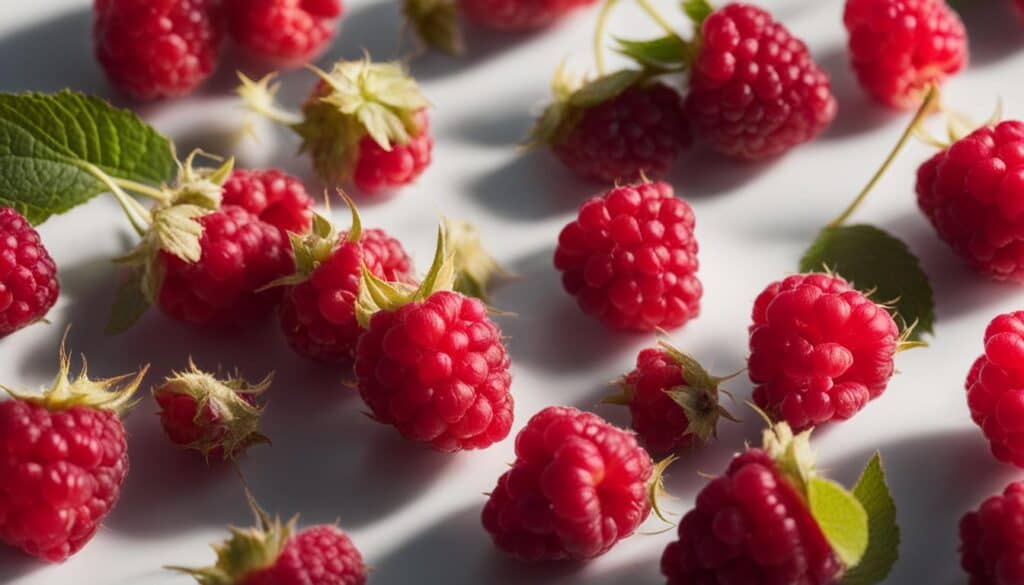
Raspberries are incredibly versatile and can be used in a wide range of dishes. Whether you’re looking to add a touch of sweetness to a dessert or a burst of flavor to a savory dish, raspberries are the perfect ingredient. Their vibrant color and tart-sweet taste make them a standout addition to any recipe.
In sweet dishes, raspberries can be used to create delectable pies, tarts, and cakes. They can also be turned into flavorful jams, sauces, and syrups that can elevate any dessert. The natural acidity of raspberries can balance out the richness of creamy desserts or add a refreshing tang to fruity treats.
Raspberries also shine in savory dishes. They can be used as a topping for salads to add a burst of freshness and color. When incorporated into marinades or used as a glaze for meats, raspberries add a unique depth of flavor that complements the savory ingredients perfectly. The possibilities are endless when it comes to using raspberries in your culinary creations.
Table: Ideas for Using Raspberries in Cooking
| Course | Ideas |
|---|---|
| Breakfast | Mix raspberries into yogurt or oatmeal for a delicious and nutritious start to your day. |
| Dessert | Create a classic raspberry pie or whip up a batch of raspberry-infused ice cream. |
| Salads | Add a handful of raspberries to your favorite salad for a pop of color and flavor. |
| Main Dishes | Use raspberries as a glaze for roasted chicken or incorporate them into a tangy barbecue sauce. |
| Beverages | Blend raspberries into smoothies or muddle them in cocktails for a refreshing twist. |
As you can see, raspberries can be used in a variety of ways to enhance your meals. Whether you’re creating a sweet treat or a savory masterpiece, raspberries are sure to delight your taste buds and impress your guests. So, don’t hesitate to experiment with different raspberry recipes and discover the endless possibilities that this versatile fruit has to offer.
Enhancing Flavors with Raspberries
Raspberries are not only delicious on their own but also have the power to enhance the flavors of other ingredients. Their natural acidity can balance out rich and fatty flavors, making them a fantastic addition to a wide range of dishes. Whether you’re creating a rich dessert or a savory dish, raspberries can take your culinary creations to the next level.
One of the great things about raspberries is their versatility in pairing with other fruits. Combining raspberries with strawberries or peaches creates dynamic flavor combinations that can elevate any recipe. The tartness of raspberries adds a refreshing and tangy twist, making your dishes more exciting and vibrant.
Raspberries can also be infused into various liquids, such as drinks, desserts, and vinaigrettes, to add a burst of flavor. You can create raspberry-infused cocktails, refreshing smoothies, or tangy salad dressings. The possibilities are endless!
Aside from their flavor-enhancing qualities, raspberries offer numerous health benefits. They are packed with antioxidants and vitamins, which contribute to improved overall health. Incorporating raspberries into your dishes not only makes them delicious but also adds a nutritional boost.
Enhancing Flavors with Raspberries
“Raspberries not only add a burst of flavor to dishes but also enhance other ingredients. Their natural acidity can balance out rich and fatty flavors, making them a great addition to rich desserts or savory dishes.”
Pairing with Other Fruits
- Strawberries
- Peaches
- Blueberries
Raspberry-Infused Ideas
- Cocktails
- Smoothies
- Vinaigrettes
Nutritional Benefits
- Antioxidants
- Vitamins
- Fiber
Getting Creative with Raspberry Recipes
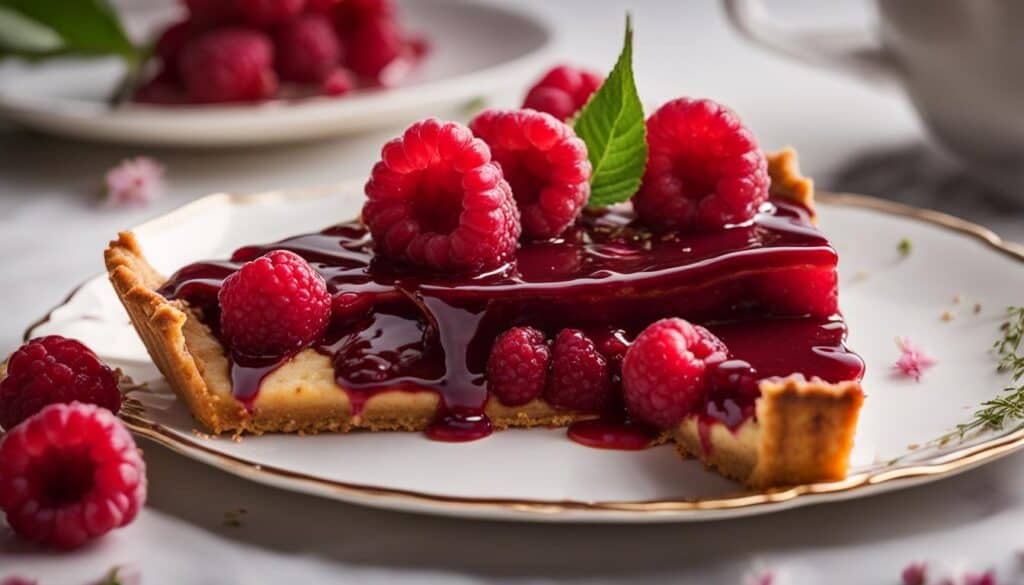
When it comes to raspberry recipes, the possibilities are endless. Whether you have a sweet tooth or prefer savory dishes, raspberries can add a burst of flavor and a pop of color to your creations. From delightful raspberry desserts like pies, cakes, and pavlovas to refreshing smoothies and jams, there’s no shortage of ways to incorporate these versatile berries into your cooking.
If you’re in the mood for something sweet, why not try making a classic raspberry pie? The combination of tangy raspberries and buttery crust is simply irresistible. Or, if you’re looking for a lighter option, whip up a refreshing raspberry smoothie. Blend together raspberries, yogurt, and a splash of honey for a delicious and nutritious treat.
For those who love the taste of raspberries in the morning, why not make your own homemade raspberry jam? Spread it on toast or use it as a filling for pastries – the possibilities are endless. And if you’re feeling adventurous, try incorporating raspberries into your savory dishes. Add them to salads for a pop of color and a touch of sweetness, or use them to create a flavorful glaze for meats.
The key to getting creative with raspberry recipes is to experiment and let your taste buds guide you. Don’t be afraid to try new flavor combinations or put your own twist on classic recipes. With their vibrant color, unique flavor, and numerous health benefits, raspberries are sure to delight your senses and elevate your cooking to new heights.
Table: Raspberry Recipes
| Recipe | Description |
|---|---|
| Raspberry Pie | A classic dessert with a tangy raspberry filling and a buttery crust. |
| Raspberry Smoothie | A refreshing blend of raspberries, yogurt, and honey. |
| Raspberry Jam | Homemade jam made with fresh raspberries. |
| Raspberry Glazed Chicken | Savory chicken glazed with a flavorful raspberry sauce. |
| Raspberry Salad | A colorful salad with a mix of greens, raspberries, and other fresh ingredients. |
Whether you’re a seasoned chef or just starting out in the kitchen, raspberry recipes offer something for everyone. So, grab a basket of fresh raspberries and let your culinary creativity run wild. With their delightful flavor and versatility, raspberries are sure to inspire you to create delicious dishes that will impress your family and friends.
Tips for Successful Raspberry Cooking
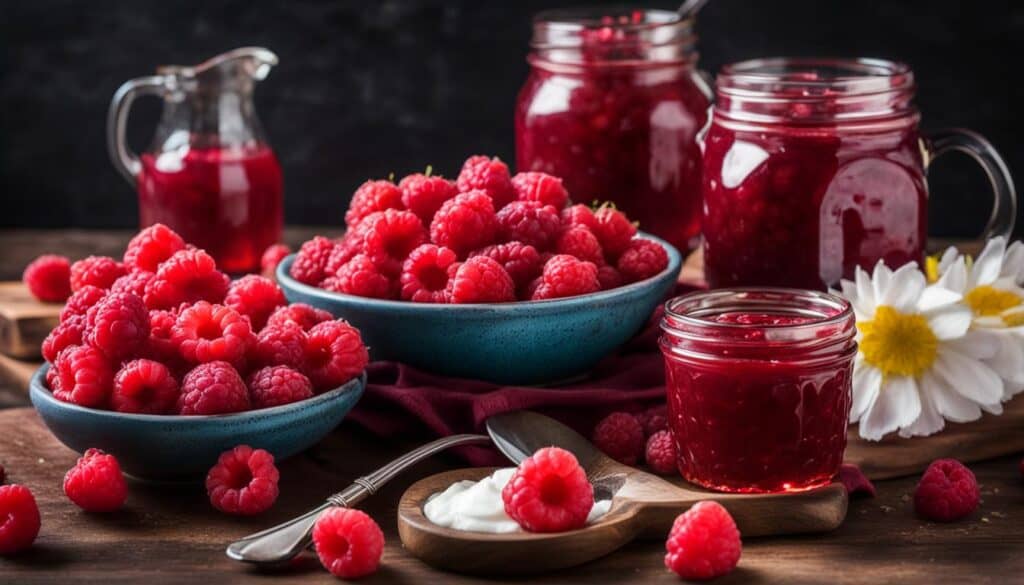
When it comes to cooking with raspberries, there are a few tips that can help ensure delicious results. First and foremost, avoid overcooking raspberries, as they can become mushy and lose their flavor. Instead, add them towards the end of the cooking process to preserve their vibrant color and fresh taste. This is especially important when making raspberry sauces or compotes, where the texture is key. To achieve a smoother texture, strain the seeds from the sauce or compote.
When selecting raspberries for cooking, look for berries that are plump, firm, and free from any signs of spoilage. The color should be vibrant and consistent. Choose organic or locally grown raspberries for the best flavor. If you are not able to use all the raspberries at once, you can freeze them for future use. Freezing raspberries is a great way to extend their shelf life and ensure you always have them on hand for your favorite recipes. Just make sure to wash and dry the raspberries thoroughly before freezing them.
There are countless ways to incorporate raspberries into your cooking. From desserts like pies and cakes to sauces and glazes for meats, the possibilities are endless. Raspberries can also be used in smoothies, jams, and even savory dishes like salads. Their tart-sweet flavor and vibrant color make them a standout ingredient in any recipe. Don’t be afraid to get creative and experiment with different flavor combinations. Pair raspberries with other fruits or even herbs to create unique and exciting dishes that showcase the versatility of these delightful berries.
| Tips for Successful Raspberry Cooking | |
|---|---|
| Avoid overcooking raspberries | Add them towards the end of the cooking process |
| Choose ripe, firm raspberries | Look for plump berries free from signs of spoilage |
| Strain seeds from raspberry sauces or compotes | For a smoother texture |
| Freeze raspberries for future use | To extend their shelf life |
Incorporating raspberries into your cooking not only adds a burst of flavor but also provides numerous health benefits. Raspberries are packed with antioxidants, vitamins, and minerals that can support heart health, reduce inflammation, and boost your immune system. So, embrace the deliciousness and nutritional value of raspberries by exploring the wide range of recipes that feature these delightful berries. From sweet to savory, there’s no limit to what you can create with raspberries in your kitchen.
Conclusion
Raspberries are a delightful fruit that can add a burst of flavor and vibrant color to your culinary creations. Whether you’re using them in sweet or savory dishes, raspberries offer endless possibilities for creativity in the kitchen.
Not only do raspberries taste delicious, but they also offer numerous health benefits. Packed with antioxidants and vitamins, raspberries can boost your immune system and improve heart health. Incorporating raspberries into your diet is a tasty way to enjoy the benefits of this nutrient-rich fruit.
With their rich history in cooking and a variety of types to choose from, raspberries are a must-have ingredient for any food enthusiast. So, don’t hesitate to embark on a raspberry-filled adventure and let your culinary creativity soar!
FAQ
What are the different types of raspberries suitable for cooking?
The different types of raspberries suitable for cooking include red, golden, black, purple, and heritage raspberries.
How do I choose ripe raspberries for cooking?
When selecting raspberries for cooking, look for berries that are plump, firm, and free from any signs of mold or mushiness. The color should be vibrant and consistent, and the green caps on top of the berries should be fresh and intact.
What is the best way to store fresh raspberries?
To ensure the freshness of your raspberries, handle them with care and store them properly. Avoid washing raspberries until you are ready to use them, as moisture can cause them to spoil quickly. Store raspberries in the refrigerator at a temperature between 32°F and 40°F (0°C and 4°C) to maintain their freshness.
How can I use raspberries in cooking?
Raspberries can be used in a variety of sweet and savory dishes. In sweet dishes, they can be used in pies, tarts, cakes, and other desserts. In savory dishes, raspberries can be used as a topping for salads, incorporated into marinades, or used as a glaze for meats.
How can I enhance the flavors of my dishes with raspberries?
Raspberries can enhance the flavors of dishes by adding a burst of tart-sweet flavor and balancing out rich and fatty flavors. They can also be paired with other fruits to create dynamic flavor combinations or infused into drinks, desserts, and vinaigrettes.
What are some popular raspberry recipes?
Some popular raspberry recipes include pies, cakes, pavlovas, smoothies, jams, sauces, and more. Raspberries are incredibly versatile and can be used in a wide variety of recipes.
Do raspberries have any health benefits?
Yes, raspberries are packed with beneficial nutrients, including antioxidants and vitamins. They offer various health benefits, such as improved heart health and reduced inflammation.
Are there any tips for successful raspberry cooking?
To successfully cook with raspberries, avoid overcooking them as they can become mushy and lose their flavor. Add raspberries towards the end of the cooking process to preserve their vibrant color and fresh taste. When making raspberry sauce or compote, strain the seeds for a smoother texture. Raspberries can also be frozen for future use to extend their shelf life.

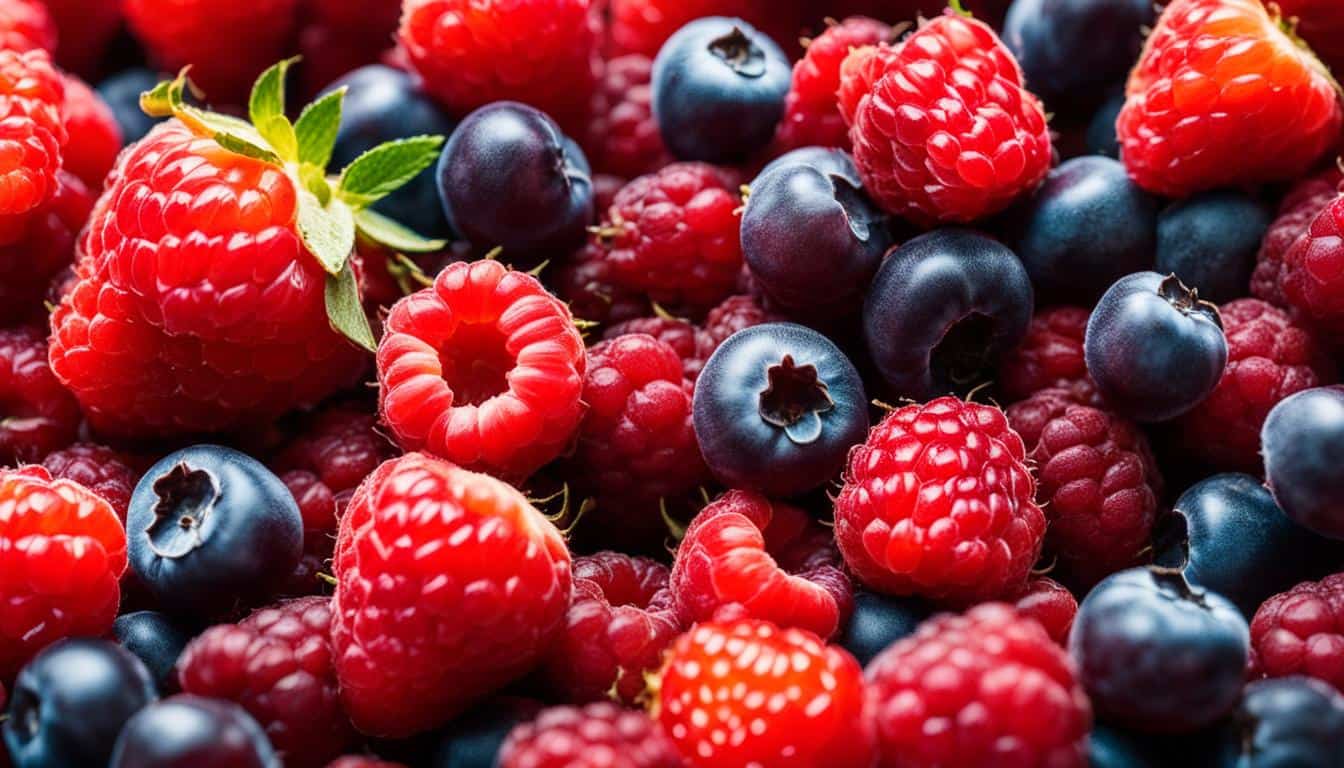



Leave a Reply